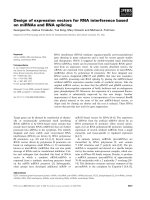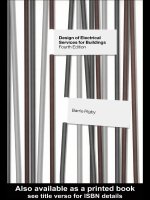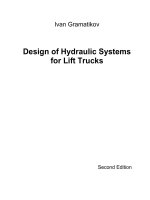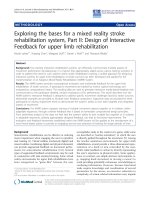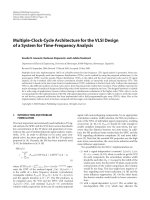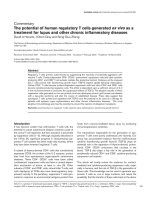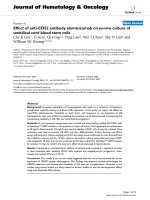Design of artificial microenvironment for cord blood CD34+ cells expansion ex vivo
Bạn đang xem bản rút gọn của tài liệu. Xem và tải ngay bản đầy đủ của tài liệu tại đây (1.12 MB, 93 trang )
Design of Artificial Microenvironment for Cord Blood
CD34+ Cells Expansion ex vivo
Yue Zhang
(M.Sc. Bioengineering, NUS)
A THESIS SUBMITTED
FOR THE DEGREE OF MASTER OF SCIENCE
GRADUATE PROGRAM OF BIOENGINEERING
NATIONAL UNIVERSITY OF SINGAPORE
2005
Acknowledgements
This thesis is the result of one and half years of work whereby I have been
accompanied and supported by many people. It is a pleasant aspect that I have now
the opportunity to express my gratitude for all of them.
The first people I would like to thank are my supervisors Professor Teoh Swee
Hin and Professor Kam W. Leong, who always kept an eye on the progress of my
work and always were available when I needed advice. Their enthusiasm on research
and mission for providing high-quality work has made a deep impression on me. I
owe them lots of gratitude for having me shown this way of research. I also would
like to thank the helpful discussion of Professor Ian McNiece, Professor Hai-Quan
Mao, and Dr Chai Chou.
My colleagues of Tissue Therapeutic Engineering lab in Division of Johns
Hopkins in Singapore gave me a lot of help in research and life. I would like to thank
Dr Xue-Song Jiang, for many discussions and collaboration in animal work. He also
provided me advice and tips that helped me a lot in staying at the right track. I thank
Mr Kian-Ngiap Chua, for the valuable technical advice in SEM imaging. I thank Mr
Roy Lee and Ms Peggy Tang for being good colleagues during the last one and half
years. They helped me a lot in animal experiment. I also want to specially thank Mr
Thong-Beng Lu and Mr Yan-Nan Du from National University of Singapore, XPS
staff from Institute of Materials Research & Engineering, for their valuable technical
support in AFM and Confocal imaging and XPS test.
In the end, I would like to thank the members of the school council for their
valuable input. I also want to thank Agency for Science, Technology and Research
(A*STAR) of Singapore and the Division of Johns Hopkins in Singapore who funded
the thesis project.
i
Table of Contents
Acknowledgements……………...…………………………………..……..………..... i
Table of Contents……………………………………………………………………...ii
Summary.......................................................................................................................vi
List of Tables..............................................................................................................viii
List of Figures...............................................................................................................ix
List of Symbols.............................................................................................................xi
Chapter 1 Introduction
1.1 Purpose.....................................................................................................................1
1.2 Motivation................................................................................................................2
1.3 Objectives and Scope...............................................................................................3
Chapter 2 Literature Survey
2.1 Review of HSC and clinic application.....................................................................5
2.1.1 Hematopoiesis and HSC..................................................................................5
2.1.2 HSC clinic application.....................................................................................6
2.1.3 Different sources of HSC in transplantation...................................................8
2.2 Review of HSC expansion.....................................................................................10
2.2.1 Selection of candidate cells for expansion....................................................10
2.2.2 Evaluation of ex vivo expansion...................................................................11
2.2.3 Expansion systems........................................................................................12
2.2.3.1 Stroma dependent expansion................................................................12
2.2.3.2 Stroma independent expansion.............................................................14
2.3 Review of HSC microenvironment........................................................................15
2.3.1 Cytokine microenvironment..........................................................................15
2.3.2 Stroma microenvironment.............................................................................18
ii
2.3.3 ECM microenvironment................................................................................19
2.3.4 3D topography...............................................................................................19
2.4 Protein immobilization and bioactivity study........................................................21
Chapter 3 Materials and methods
3.1 Materials:....................................................................................................................23
3.1.1 Biological materials...........................................................................................23
3.1.2 Chemical materials............................................................................................23
3.2 MSC and CB CD34+ cells co-culture ......................................................................24
3.2.1 MSC culture......................................................................................................24
3.2.2 Ex vivo expansion of CB CD34+ cells in co-culture systems.........................24
3.2.3 CFC....................................................................................................................26
3.2.4 Animal engraftment...........................................................................................26
3.3 MSC and CB CD34+ cells 3D co-culture..................................................................27
3.3.1 MSC culture in 3D system and assays..............................................................27
3.3.2 Ex vivo expansion of CB CD34+ cells in 3D co-culture systems and
functional assays...............................................................................................28
3.4 Study of FN immobilization bioactivity....................................................................28
3.4.1 FN conjugation and adsorption.........................................................................28
3.4.2 Chemical and physical characterization of the surface.................................29
3.4.3 Biological characterization of the surfaces...................................................30
3.5 Statistical analysis..................................................................................................32
Chapter 4 MSC and CB CD34+ cells co-culture
4.1 Screening of co-culture conditions.............................................................................33
4.1.1 MSC metabolic level in StemSpan medium..................................................33
4.1.2 Optimize expansion scale..............................................................................33
iii
4.1.3 Co-culture over MSC feeder layer................................................................35
4.1.3.1 Irradiated and non irradiated feeder layer............................................35
4.1.3.2 Feeder layer exchanged and non exchanged co-culture ......................36
4.1.4 Co-culture over MSC pellet..........................................................................36
4.2 Study of the contact and non-contact co-culture...................................................38
4. 3 Function assays of contact and non-contact co-culture.........................................40
4.3.1 Phenotype screening of the expanded cells I.................................................40
4.3.2 CFC I.............................................................................................................42
4.3.3 Animal engraftment I........................................................................................42
4.4 Discussion..............................................................................................................44
Chapter 5 MSC and CB CD34+ cells 3D co-culture
5.1 Screening of 3D scaffolds......................................................................................47
5.2 Study of 3D and 2D co-culture..............................................................................48
5.3 Functional assays of 3D and 2D co-culture...........................................................49
5.3.1 Phenotype screening of the expanded cells II..................................................49
5.3.2 CFC II...........................................................................................................51
5.3.3 Animal engraftment II...................................................................................52
5.4 3D culture of MSC.....................................................................................................53
5.5 Discussion..............................................................................................................54
Chapter 6 Study of FN immobilization bioactivity
6.1 Physical and chemical characterization of conjugated and adsorbed FN..............58
6.1.1 FN immobilization efficiency.......................................................................58
6.1.2 XPS assay......................................................................................................59
6.1.3 Surface contact angle measurements.............................................................60
6.1.4 AFM assay.....................................................................................................60
iv
6.2 Biological characterization of conjugated and adsorbed FN..................................62
6.2.1 ELISA test for RGD domain.........................................................................62
6.2.2 Ex vivo cell experiment.................................................................................63
6.3 Discussion..............................................................................................................63
6.3.1 FN conformation and its bioactivity........................................................63
6.3.2 FN adsorption..........................................................................................64
6.3.3 FN conjugation and fibrillogenesis.........................................................64
Chapter 7 Conclusions
7.1 Conclusions……………………………..…………………………………………68
7.2 Future prospect……………………………………………………………….……71
References........................................................................................................................73
v
Summary
Allogeneic transplantation of CB is limited by insufficient number of HSC as
well as PHPC. An efficient ex vivo expansion of CB can overcome this limitation. An
ideal ex vivo expansion condition should mimic the in vivo hematopoietic
microenvironment, which can efficiently expand the cell number while still
maintaining the “stemness” of the cells.
MSC, as non hematopoietic, well-characterized skeletal and connective tissue
progenitor cells within the bone marrow stroma, have been investigated as support
cells for the culture of HSC/PHPC. They are attractive for the rich environmental
signals that they provide and their immunologic compatibility and supporting effect in
transplantation. In this study we clearly demonstrated the benefit of MSC inclusion in
HSC expansion ex vivo. We also compared the contact and non-contact cultures of
the two cell types; the cell-cell direct interaction was necessary for the efficient
expansion of HSC.
HSC-MSC co-cultures have only been performed in 2D configuration. We
postulate that a 3D culture environment that resembles the natural in vivo
hematopoietic compartment would be more conducive for regulating HSC expansion.
The result showed that the direct contact between MSC and HSC in 3D cultures led to
statistically-significant higher expansion of CB CD34+ cells compared to 2D cocultures: 891- versus 545-fold increase in total cells, 96- versus 48-fold increase of
CD34+ cells, and 230- versus 150-fold increase in CFC. NOD/SCID mouse
engraftment assays also indicated a high success rate of hematopoiesis reconstruction
with these expanded cells. This enhanced expansion result was probably due to the
ECM secreted by MSC, especially FN, which facilitated the interaction with the
seeded CD34+ cells.
vi
Based on this finding, we hypothesize that the immobilization of ECM protein
FN onto the surface of culture systems might represent another stroma free expansion
strategy. A key problem in FN immobilization is the change of bioactivity during the
immobilization process. By comparing the FN bioactivity after two common
immobilization pathways: conjugation and adsorption, we found that the adsorption
method maintained a normal conformation of FN, leading to less change of its
bioactivity in the access of RGD domains and cell adhesion ability. The covalent
conjugation process, on the other hand, induced FN unfolding and fibrillogenesis ex
vivo, which blocked the access of active RGD domains and suppressed fibroblast
cells adhesion. This bioactivity variance on the level of immobilization methods may
provide us a way to control the function of the immobilized protein, which can be
helpful for the construction of an artificial niche.
vii
List of Tables
Number
Page
1. Surface markers expression of expanded cells I ...................................................41
2. The engraftment and lineage expression by human cells in the bone marrow of
NOD/SCID mice I..................................................................................................43
3. Surface markers expression of expanded cells II ..................................................50
4. The engraftment and lineage expression by human cells in the bone marrow of
NOD/SCID mice II.................................................................................................53
5. Element proportion on FN immobilized surface....................................................60
viii
List of Figures
Number
Page
1. Hematopoietic system hierarchy..................................................................................6
2. Scheme of FN immobilization on aminated PET surface.........................................29
3. MSC metabolic level in MSCGM medium or Stemspan serum free medium with
cytokines.................................................................................................................34
4. CB CD34+ cells expansion in 96-well or 24-well tissue culture plates..................34
5. CB CD34+ cells expansion on irradiated or non irradiated MSC feeder layers... 35
6. CB CD34+ cells expansion with or without exchange of MSC feeder layer in the
middle of co-culture...................................................................................................36
7. CB CD34+ cells expansion on MSC feeder layer or adherent MSC pellet..............37
8. MSC pellet morphology under phase contrast microscope.......................................37
9. CB CD34+ cells expansion in contact co-culture or non-contact co-culture.........39
10. Cell-cell contact study by CMFDA and CD34 expression.......................................39
11. CFC properties of expanded cells I............................................................................42
12. SEM image of PET meshes and co-culture in meshes...........................................47
13. CB CD34+ cells expansion in PET woven or unwoven mesh...............................48
14. CB CD34+ cells expansion in 2D or 3D systems..................................................49
15. CFC properties of expanded cells II...........................................................................51
16. MSC attachment, proliferation and protein production in 2D or 3D systems...........54
17. SEM and Confocol image of MSC culture and co-culture in 2D or 3D system.......55
18. FN immobilization efficiency....................................................................................59
19. XPS survey of FN immobilized PET surface............................................................59
20. Surface contact angle on clean, modified or FN immobilized PET surface.............61
21. AFM image of FN immobilized PET surface............................................................61
22. ELISA measurement of active RGD domains in immobilized FN compared with
Micro-BCA result.......................................................................................................62
23. Cell adhesion on FN immobilized PET surface.........................................................63
ix
24. Hypothetical schemes of FN fibrillogenesis in conjugation process ........................66
x
List of Symbols
BM: Bone marrow
BMP: Bone morphogenetic protein
CB: Cord blood
CFC: Cloning forming cell
CFU-E: Colony forming unit erythrocyte colony-forming units
CFU-GEMM: Colony forming unit granulocyte, erythrocyte, monocyte,
megakaryocyte
CFU-GM: Colony forming unit granulocyte/macrophage colony-forming units
CLP: Common lymphocyte progenitor
CMP: Common megacytes progenitor
ECM: Extra cellular matrix
EPO: Erythropoietin
FBS: Fetal bovine serum
FGF: Fibroblasts growth factor
FL: Flt-3 ligand
FN: Fibronectin
G-CSF: Granulocyte-colony stimulating factor
GM-CSF: Granulocyte/macrophage colony-stimulating factor
GMP: Granulocyte / monocyte progenitor
GVHD: Graft-versus-host disease
HGF: Hematopoietic growth factor
HLA: Human leukocyte antigen
HSC: Hematopoietic stem cells
IL: Interleukin
xi
LIF: Leukemia inhibitory factor
LTC-IC: Long-term culture initiating cell
LTR: Long term repopulating
M-CSF: Macrophage-colony stimulating factor
MkEP: Megakaryocytes, erythrocytes progenitor
MNC: Mono-nucleus cells
MSC: Mesenchymal stem cells
NOD/ SCID: Non-obese diabetic/ severe combined immunodeficiency
PB: Peripheral Blood
PET: Polyethylene terephthalate
PHPC: Primitive hematopoietic progenitor cell
SCF: Stem cell factor
STR: Short term repopulating
TCPS: Tissue culture plates
TGF: Transforming growth factor
TNF: Tumor necrosis factor
TPO: Thrombopoietin
VLA-4/5: Very late antigen-4/5
2D: Two dimensional
3D: Three dimensional
xii
CHAPTER 1
INTRODUCTION
1.1 Purpose
All mature cells in the blood and immune system are derived from HSC and
all of these cell types can be generated from a single HSC [Osawa et al (1996)]. This
tremendous potential for reconstituting the hematopoietic system has allowed the
development of transplantation of HSC as a clinical strategy. HSC obtained directly
from the patient (autologous HSC) are used for rescuing the patient from the effects of
high doses of chemotherapy or used as a target for gene therapy vectors. HSC
obtained from another person (allogeneic HSC) are used to treat hematological
malignancies by replacing the malignant hematopoietic system with normal cells.
Allogeneic HSC can be obtained from siblings (matched sibling transplants), parents
or unrelated donors (mismatched unrelated donor transplants). Currently, about
45,000 patients each year are treated by HSC transplantation, a number that has been
increasing during the past decade.
There are several different sources for obtaining HSC for transplantation. One
important new source of HSC is CB that is collected during newborn deliveries. In
addition to their widespread availability, these HSC have several useful properties,
including their decreased ability to induce immunological reactivity against the
patient because of increased levels of immune tolerance in the fetus. Interest in this
approach has increased since the first successful transplantation of cord-blood HSC in
1988 [Gluckman et al (1989)], and there are now an estimated 70,000 units of CB that
are stored and available for transplantation [Gluckman (2001)]. However, their use is
limited by the number of HSC that can be collected, and it is clear that engraftment is
1
closely correlated with the number of cells that are infused [Wagner et al (2002)]. For
optimum engraftment, current transplantation requires at least 2,500,000 CD34+ cells
per kilogram of patient body weight [Koller et al (1993)]. An optimally collected CB
donation generates approximately 10,000,000 CD34+ cells, which is just 10-15% of
the optimal dose for an adult. For this reason, CB transplantation is limited to
pediatric patients right now. Furthermore, because the stem cells in CB are more
primitive than those in marrow, the hematopoietic recovery using CB stem cells is
approximately 25 days for neutrophils and 43 days for platelets [Leary et al (1988)],
which is significantly slower than that obtained in BM transplantation. And it leaves
the patient vulnerable to a fatal infection for a longer period of time.
To address these limitations, an effective strategy to expand CB cells ex vivo,
increasing stem cells for transplantation would considerably improve the therapeutic
potentials. What’s more, the ex vivo expansion produces more mature precursors,
supplementing stem cells graft, which help to shorten and potentially prevent
chemotherapy induced pancytopenia. The purpose of the research presented here is to
develop a more compatible and efficient system of increasing CB ex vivo expansion,
while still keeping the stem cells properties.
1.2 Motivation
The ability of environmental cues to affect stem cell fate is a concept from
embryology that has been extended to the adult organism with the notion that a highly
specialized set of conditions exists to regulate the ultimate fate of anatomically
restricted primitive cells. The physical interaction of stem cells with stroma cells,
matrix components and supportive factors is thought to define a niche critical for the
homeostatic maintenance of stem cell populations. For example the HSC changes the
2
location during development moving from extra embryonic regions to the aortogonadal-mesonephros in the embryo and then to the liver in the first trimester. By the
second trimester, BM, spleen and thymus become populated and eventually become
the exclusive sites of hematopoiesis. With each change in location is an associated
change in the production emphasis of the stem cell population, with stem cell
expansion and erythropoiesis in great dominance early and a more balanced, full
immune repertoire of expansion later. Inspired by the research in hematopoiesis
microenvironment, we planned to reconstruct the hematopoiesis niche ex vivo for
more reliable expansion of CB cells.
1.3 Objectives and Scope
The objective of reconstructing hematopoiesis microenvironment ex vivo for
more efficient HSC expansion is achieved by the following specific approaches:
•
The incorporation of MSC as stroma in supporting CB expansion (Chapter 4).
MSC are well characterized skeletal and connective tissue progenitor cells
within bone marrow. They can provide rich environment signals and show good
immunological compatibility in transplantation. For these reasons, we incorporated
MSC into expansion system. First of all, we screened and optimized the co-culture
conditions, and then we studied on the direct cell-cell contact effect during the coculture. The expansion result was evaluated by functional assays ex vivo and in vivo.
•
The incorporation of 3D scaffold in co-culture of CB and MSC (Chapter 5).
We postulated that 3D culture environment that resembles the natural niche
would be more conductive for CB expansion, thus we incorporated the 3D scaffold
into MSC and CB co-culture system. We first screened and optimized the 3D scaffold
for co-culture, and then we compared the 2D co-culture with 3D co-culture through
3
expansion and functional assays. Finally we studied MSC culture and its ECM
secretion in 3D scaffold, which probably explained the higher expansion result in 3D.
•
The bioactivity study of immobilized FN, as a supportive research for its
further application in CB expansion (Chapter 6)
Inspired by the co-culture result that FN was specially secreted by MSCs in
supporting CB’s expansion, we hypothesized that the immobilization of FN onto the
surface of culture system may represent another stroma free expansion strategy. A key
problem in this strategy is how to control the bioactivity of immobilized FN. In this
study, we aimed to study the bioactivity of FN after different immobilization
pathways: conjugation and adsorption. The chemical and physical properties of the
immobilized surfaces were studied by Micro-BCA, surface contact angle with water
and AFM. The biological properties of the immobilized surfaces were evaluated by
fibroblast adhesion assay and ELISA test for active RGD domain.
4
CHAPTER 2
LITERATURE SURVEY
2.1 Review of HSC and its clinic application
2.1.1 Hematopoiesis and HSC
Blood cells are responsible for constant maintenance and immune protection
of every cell type of the body, which can be classified into two main classes,
lymphoid cells (T, B, and natural killer cells) and myeloid cells (granulocytes,
monocytes, erythrocytes, and megakaryocytes). All blood cells have a limited lifespan:
several hours for granulocytes, several weeks for red blood cells, and up to several
years for memory T cells. Thus, a vast amount of blood cells must be permanently
produced. In normal adults, the body produces about 2.5 billion red blood cells, 2.5
billion platelets, and 10 billion granulocytes per kilogram of body weight per day
[Williams et al (1990)]. Hematopoiesis: the regulated production of eight different
blood cells is a continual process that is the result of proliferation and differentiation
of a small common pool of pluripotent cells called HSC, committed progenitor cells,
and differentiated cells. Within these three stages, extensive expansion of cell
numbers occurs through cell division. A single stem cell has been proposed to be
capable of more than 50 cell divisions or doublings and has the capacity to generate
up to 1015 cells, or sufficient cells for up to 60 years [Kay (1965)].
Alexander Maximow, working in St. Petersburg as a military doctor in 1909,
was the first to suggest that there is a HSC with the morphological appearance of a
‘lymphocyte’ capable of migrating through the blood to micro-ecological niches that
would allow them to proliferate and differentiate along lineage specific pathways
[Maximow (1909]]. The first evidence and definition of blood-forming stem cells
5
came from studies of people exposed to lethal doses of radiation in 1945. Basic
research soon followed. After duplicating radiation sickness in mice, scientists found
they could rescue the mice from death with bone marrow transplants from healthy
donor animals. In the early 1960s, Till and McCulloch began analyzing the bone
marrow to find out which components were responsible for regenerating blood [Till
and McCullough (1961)]. They defined what the two hallmarks of an HSC remain: it
can renew itself and it can produce cells that give rise to all the different types of
blood cells. For these characters, HSC has huge application in clinics.
Figure 1 Hematopoietic system hierarchy. Dividing pluripotent stem cells (LTR and
STR) may undergo self-renewal to form daughter cells without loss of
potential, and also experienced a concomitant differentiation to form
oligopotent daughter cells (CLP, CMP, and CMP lead to GMP and MkEP)
with more restricted potential. Continuous proliferation and differentiation
result in the production of many mature cells. Macrophages are obtained
from monocytes and similarly platelets are derived from megakaryocytes.
2.1.2 HSC clinic application
A: Leukemia and Lymphoma
6
Among the first clinical uses of HSC were the treatment of cancers of the
blood—leukemia and lymphoma, which result from the uncontrolled proliferation of
white blood cells. In these applications, the patient’s own cancerous hematopoietic
cells were destroyed via radiation or chemotherapy, and then replaced with a bone
marrow transplant, or with a transplant of HSC collected from the peripheral
circulation or the CB of matched donors.
B: Inherited Blood Disorders
Another use of allogeneic bone marrow transplants is in the treatment of
hereditary blood disorders, such as different types of inherited anemia (failure to
produce blood cells), and inborn errors of metabolism (genetic disorders characterized
by defects in key enzymes needed to produce essential body components or degrade
chemical byproducts). The blood disorders include aplastic anemia, beta-thalassemia,
Blackfan-Diamond syndrome, globoid cell leukodystrophy, sickle-cell anemia, severe
combined immunodeficiency, X-linked lympho proliferative syndrome, and WiskottAldrich syndrome.
C: Cancer Chemotherapy
Chemotherapy aimed at rapidly dividing cancer cells inevitably hits another
target—rapidly dividing hematopoietic cells. Doctors may give cancer patients an
autologous stem cell transplant to replace the cells destroyed by chemotherapy. They
do this by mobilizing HSC and collecting them from peripheral blood. The cells are
stored while the patient undergoes intensive chemotherapy or radiotherapy to destroy
the cancer cells. Once the drugs have washed out of a patient’s body, the patient
receives a transfusion of his or her stored HSC.
D: Other Applications
7
For example: One of the most exciting new uses of HSC transplantation puts
the cells to work attacking otherwise untreatable tumors.
Most of the therapies above require the use of allogeneic HSC Transplantation,
as the patients’ own HSC were damaged or dysfunctional. However, there was
significant risk of patient death soon after the transplantation either from infection or
from GVHD. Clinics usually try to find a matched donor who is typically a sister or
brother of the patient who has inherited similar HLA on the surface of their cells to
reduce the risk. In a study where all patients received an HLA-matched transplant
from a sibling, and the results were controlled for age, the relative risk of CB versus
bone marrow was 0.41 for acute GVHD and 0.35 for chronic GVHD[Kondo et al,
2003].
2.1.3 Different sources of HSC in transplantation
A: BM
The classic source of HSC is bone marrow. For more than 40 years, doctors
performed bone marrow transplants by anesthetizing the stem cell donor, puncturing a
bone—typically ilium or iliac bone of pelvis —and drawing out the bone marrow
cells with a syringe. About 1 in every 100,000 cells in the marrow is a long-term,
blood-forming stem cell; other cells present include stroma cells, blood progenitor
cells, and mature and maturing white and red blood cells.
B: PB
It has been known for decades that a small number of stem and progenitor
cells circulate in the bloodstream, but in the past 10 years, researchers have found that
they can coax the cells to migrate from marrow to blood in greater numbers by
injecting the donor with a cytokine, such as GCSF. The donor is injected with GCSF a
8
few days before the cell harvest. To collect the cells, doctors insert an intravenous
tube into the donor’s vein and pass his blood through a filtering system that pulls out
CD34+ white blood cells and returns the red blood cells to the donor. For clinical
transplantation of human HSC, doctors now prefer to harvest donor cells from
peripheral, circulating blood which is easier on the donor—with minimal pain, no
anesthesia, and no hospital stay. The peripherally harvested cells contain twice as
many HSC as stem cells taken from bone marrow and engraft more quickly. This
means patients may recover white blood cells, platelets, and their immune and clotting
protection several days faster than they would with a bone marrow graft.
C: CB
In the late 1980s and early 1990s, physicians began to recognize that blood
from the human umbilical cord and placenta was a rich source of HSC. This tissue
supports the developing fetus during pregnancy, is delivered along with the baby, and,
is usually discarded. Since the first successful umbilical CB transplants in children
with Fanconi anemia, the collection and therapeutic use of these cells has grown
quickly.
Scientists in the laboratory and clinic are beginning to measure the differences
among HSC from different sources. In general, they find that HSC taken from tissues
at earlier developmental stages like CB may hold an advantage in telomere length for
a greater ability to self-replicate, and are less likely to be rejected by the immune
system—making them potentially more useful for therapeutic transplantation. The
accepted explanation is that CB carries much less GVHD than bone marrow because
the newborn baby is "immunologically immature" – for example, the immune system
has not had time to be exposed to various foreign bodies and develop reactions against
them [Rocha (2000)].
9
2.2 Review of HSC expansion
There are three major aspects of stem cell expansion that impact clinical
feasibility.
•
First is the ability to isolate and characterize an optimal candidate cell
population for expansion.
•
Second is to define the desired characteristics of the population to be used for
engraftment including ways to measure those characteristics.
•
Third is the development of reagents and reproducible procedures to support
the culture of a highly defined cell product for transplantation.
2.2.1 Selection of candidate cells for expansion
There are a number of issues related to the selection of a candidate stem
population for ex vivo expansion. Before determining if a protocol results in the
expansion of a stem cell, one must define what a stem cell is. Based on transplantation
of marked stem cells in murine model system, a “stem cell” is defined as a cell with
multi-lineage in vivo hematopoietic reconstituting potential, but has not yet been
proven in humans. Instead, monoclonal antibodies that react with cell-surface proteins
on hematopoietic cells have been used to define and isolate populations of candidate
stem cells phenotypically for further analysis. It is reasonable, though, to assume that
under ideal conditions one would try to expand the most primitive population that one
could identify. However, because of the close timing between preparative regimen
and re-infusion, the standard long-term biological assays for stem cells are impractical
for quantitating the level of expansion. Therefore, the only practical criteria for
infusion would likely be based on phenotypic analysis of the expanded product with
retrospective determination of hematopoietic potential ex vivo. Consequently, it is
10
important to choose a population for expansion that displays a strong correlation
between phenotype and functional activity.
It is widely held that the cell-surface glycoprotein CD34 is expressed on
almost all cells with discernable hematopoietic potential [Krause et al (1996)], as
determined by ex vivo models of progenitor cell proliferation such as CFC and
LTCIC assays [Sutherland et al (1990)]. In more recent years, though, additional
markers have been used to fractionate the CD34+ cells further into lineage-committed
progenitors and more primitive “stem” cells [Terstappen et al (1991)]. Data from
evaluation of sub fractions of CD34+ cells indicated that those cells expressing a
CD34+/CD38- phenotype are highly enriched for very primitive hematopoietic cells
[Baum et al (1992)]. In general, there is a strong correlation between these cellsurface phenotypes and biological activity in primary cells isolated from different
tissue sources (fetal liver and BM, CB, PB).
2.2.2 Evaluation of ex vivo expansion
Ultimately, preservation of cell function is the determining criteria in the
success of ex vivo human HSC culture systems. Cell function can be queried ex vivo
using the CFC and LTC-IC assays, techniques that detect the presence of committed
and multi potent cells on the basis of the formation of morphologically distinguishable
colonies either directly in methylcellulose cultures (CFC), or after greater than 5
weeks on stroma feeder layers (LTC-IC) [Hogge et al (1996)]. In vivo functional
assays for HSC have been developed on the basis of the ability of these cells to
reconstitute hematopoiesis in the BM of SCID/NOD mice following intravenous
injection [Vormoor et al (1994)]. These so-called NOD/SCID-repopulating cells are
considered human HSC that home to and engraft the murine bone marrow, where they
11
subsequently proliferate and differentiate into multiple lineages [Cashman et al
(1997)].
2.2.3 Expansion systems
HSC must maintain a balance between self-renewing cell divisions (needed to
ensure their existence throughout the life of an organism) and differentiation (needed
to replace the loss of mature cell populations).The successful maintenance and
expansion of transplantable HSC ex vivo requires triggering stem cells to proliferate
without undergoing differentiation. Cultured HSC must additionally avoid apoptosis
and maintain the ability to home, engraft, and differentiate into appropriate receptive
tissues. Because the regulation of these processes involves interactions between cellsurface receptors and a large group of soluble and matrix bound modulators of cell
function, many investigators have focused on developing culture systems
supplemented with stroma, appropriate combinations of stimulatory factors to
maintain and expand HSC ex vivo. Primarily the ex vivo expansion processes can be
divided into two groups: stroma dependent and stroma independent.
2.2.3.1 Stroma dependent expansion
Before the development of recombinant human cytokines, in the traditional
cultivation process, a stroma layer was known to produce ECM components and
growth factors to support PHPC expansion. The first successful hematopoietic culture
was performed by Dexter’s group, who used murine BM to develop a confluent
stroma layer [Dexter et al (1973)]. The addition of hydrocortisone to the medium
allowed the development of human BM stroma layers, which were found to support
HSC expansion from a variety of sources. [Quesenberry et al (1991)]. A second
12
